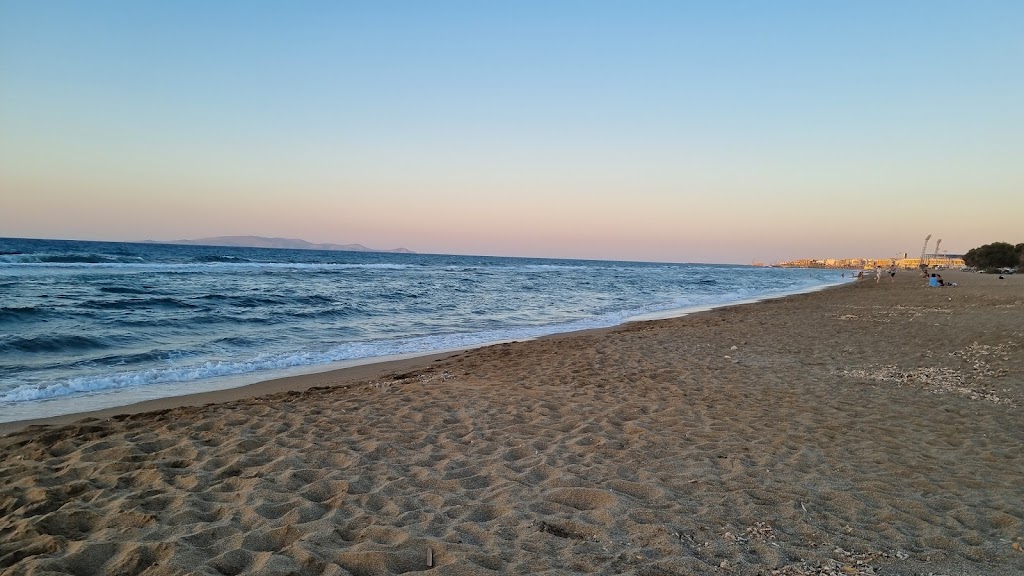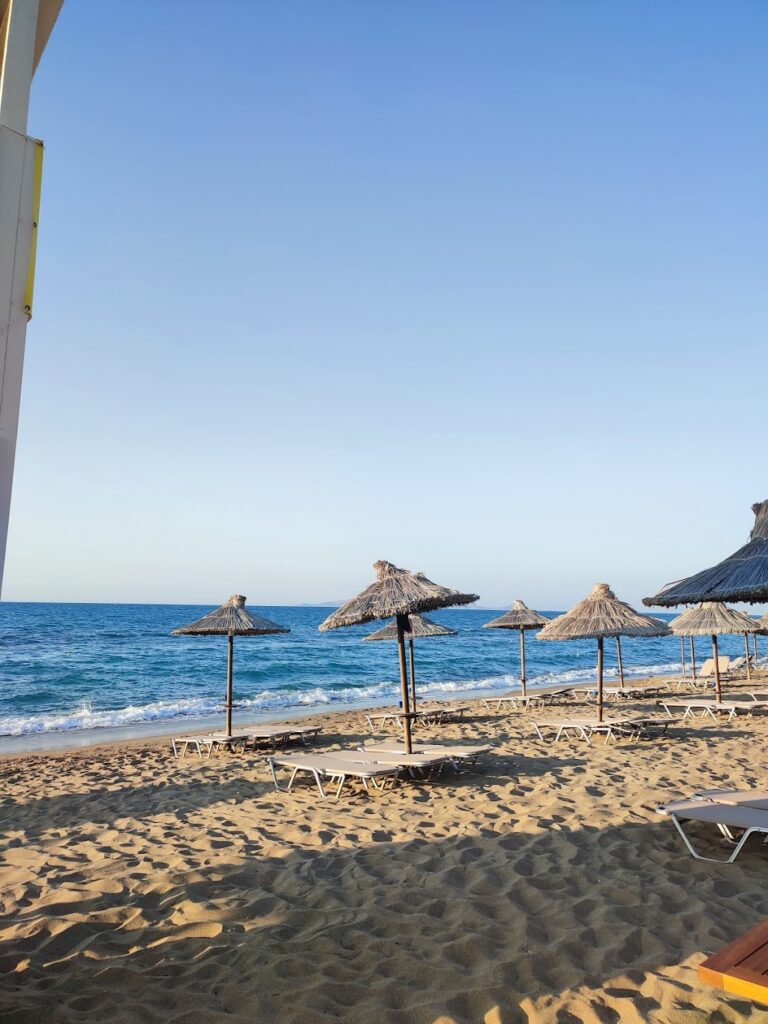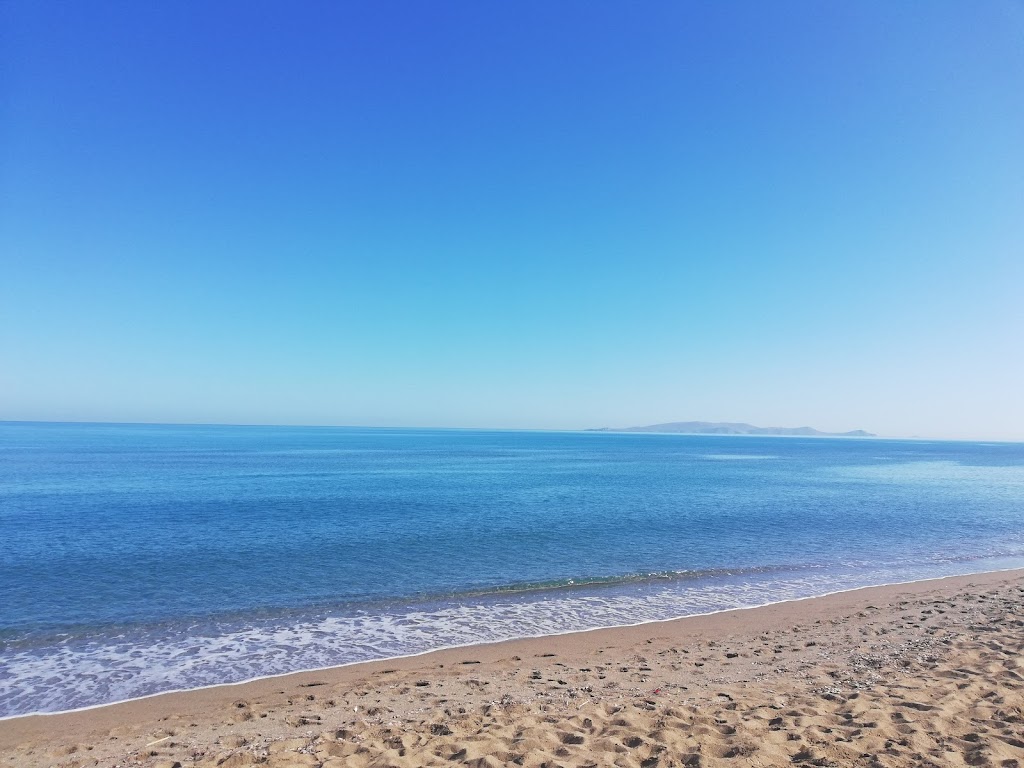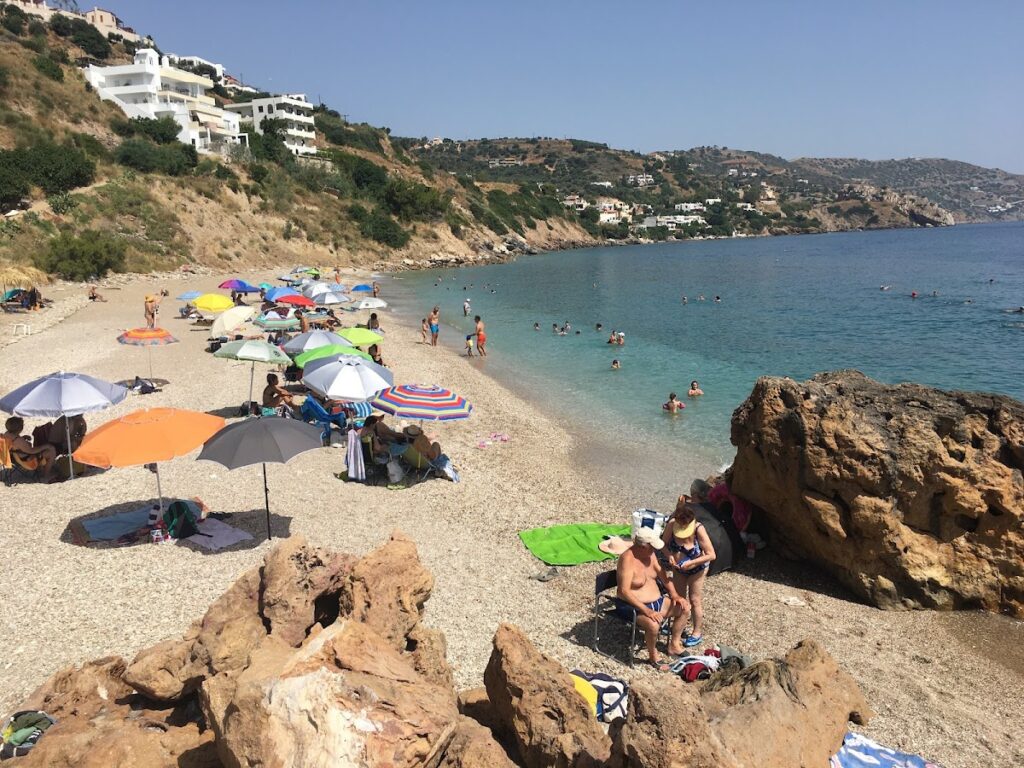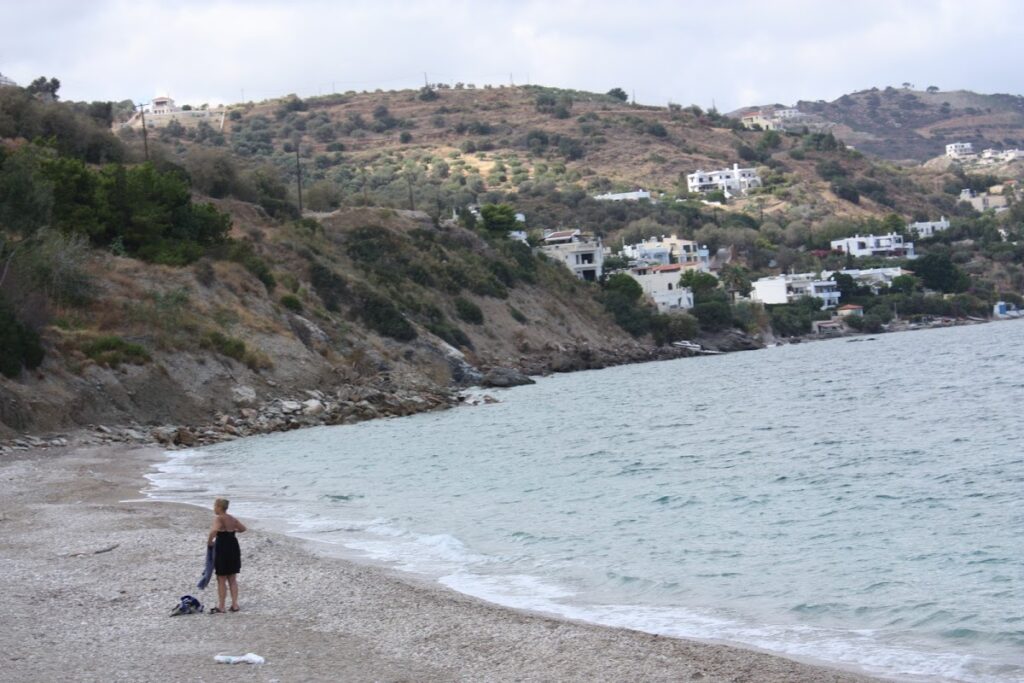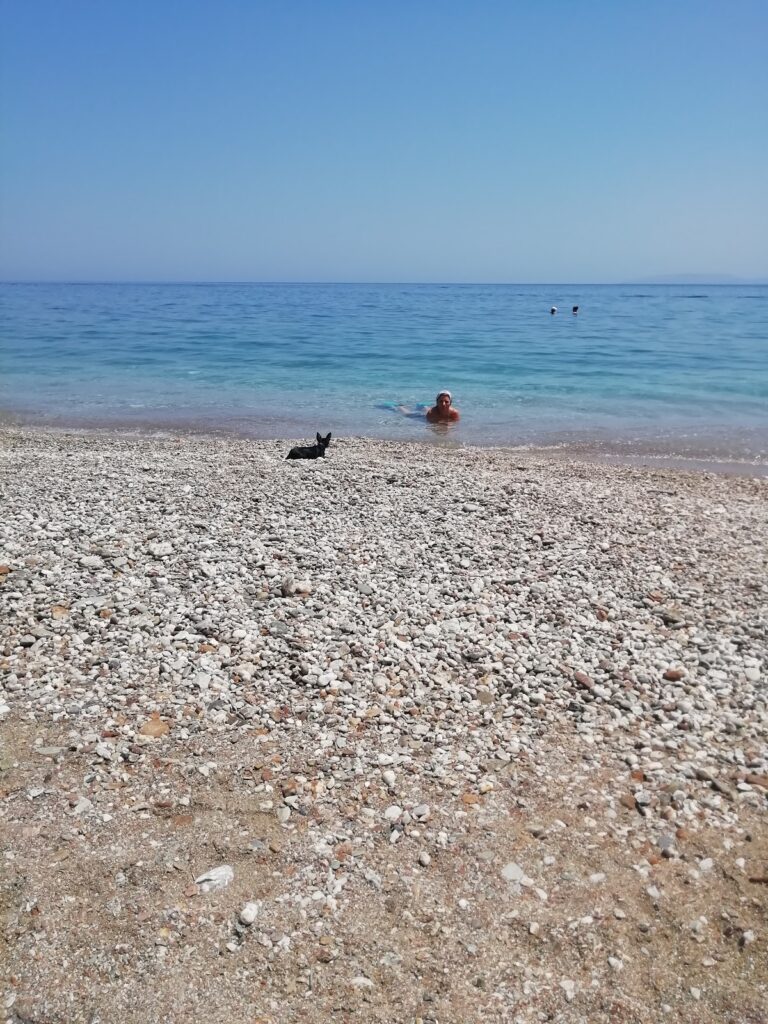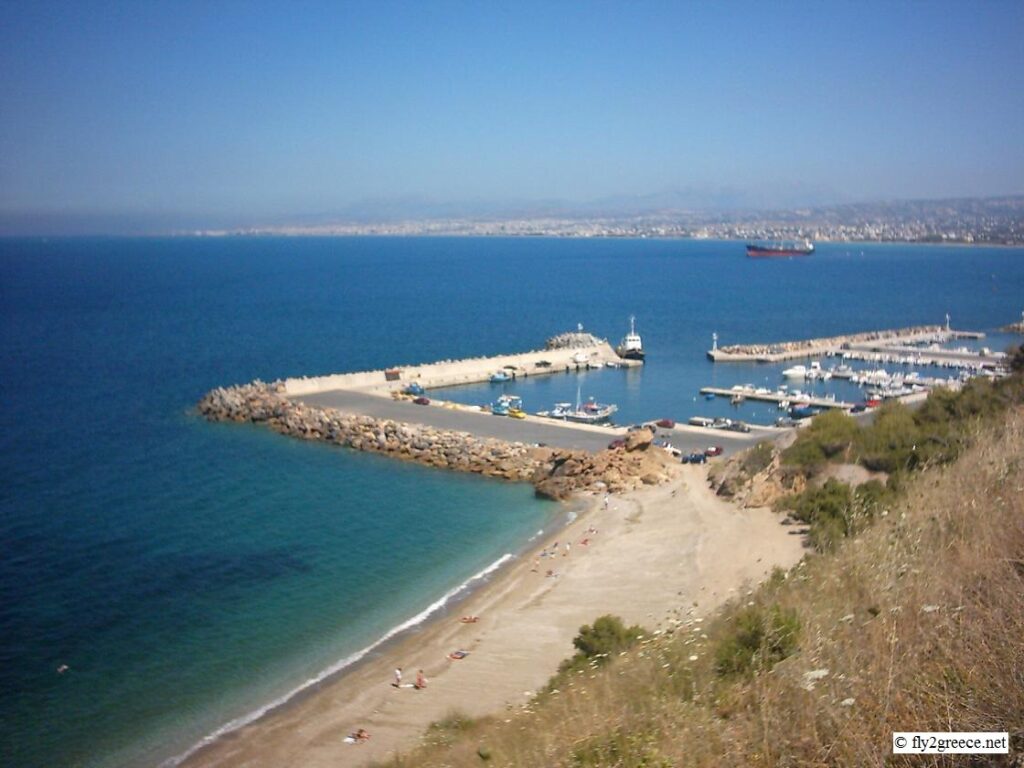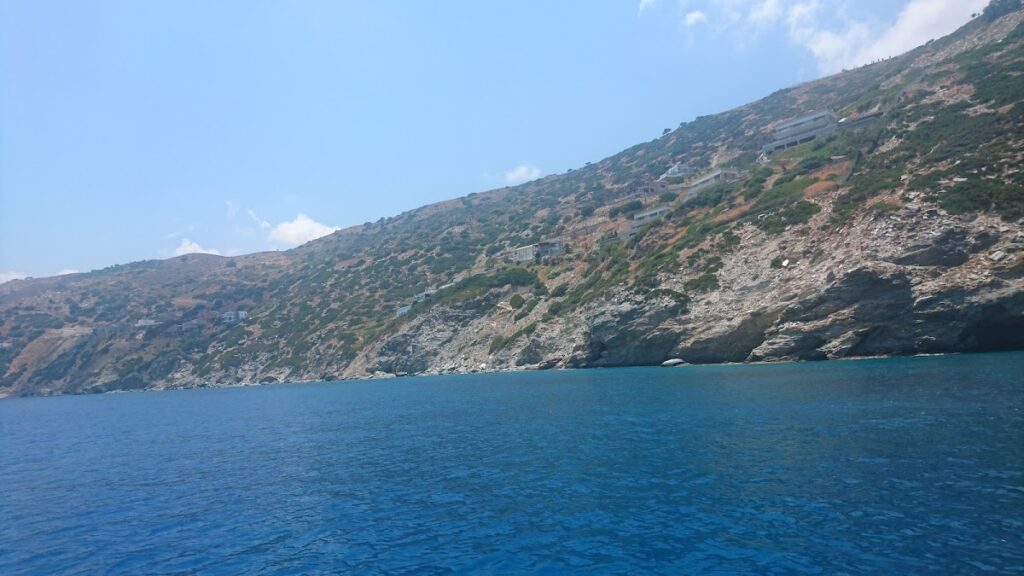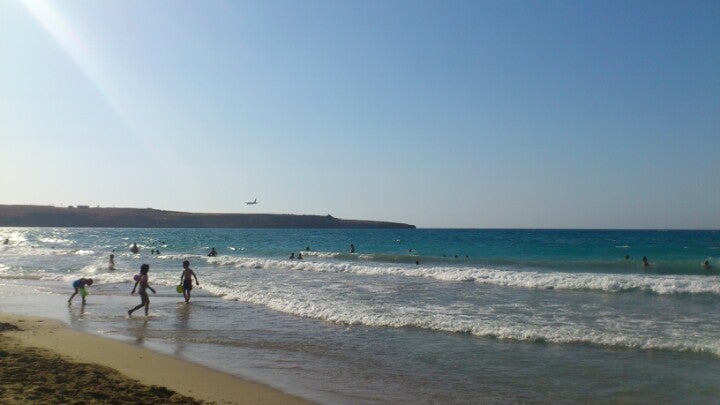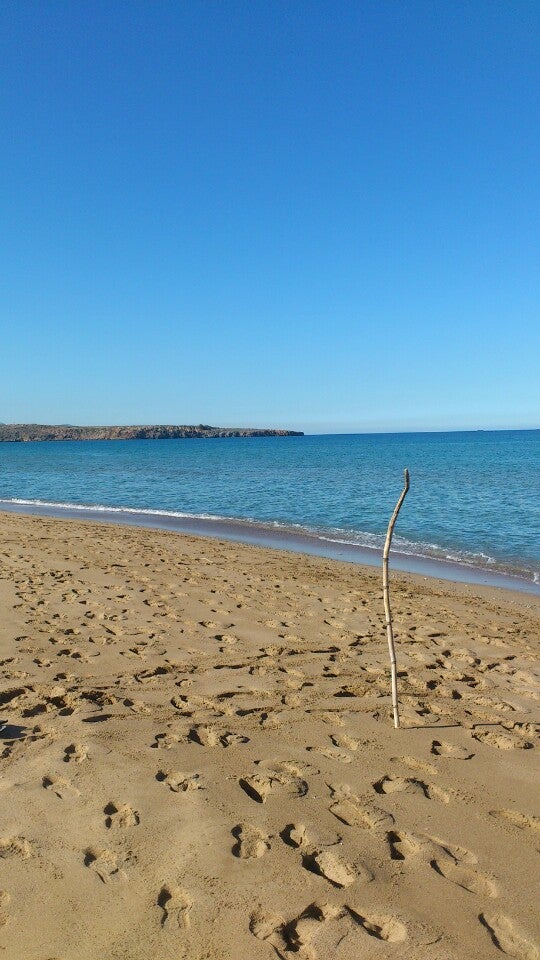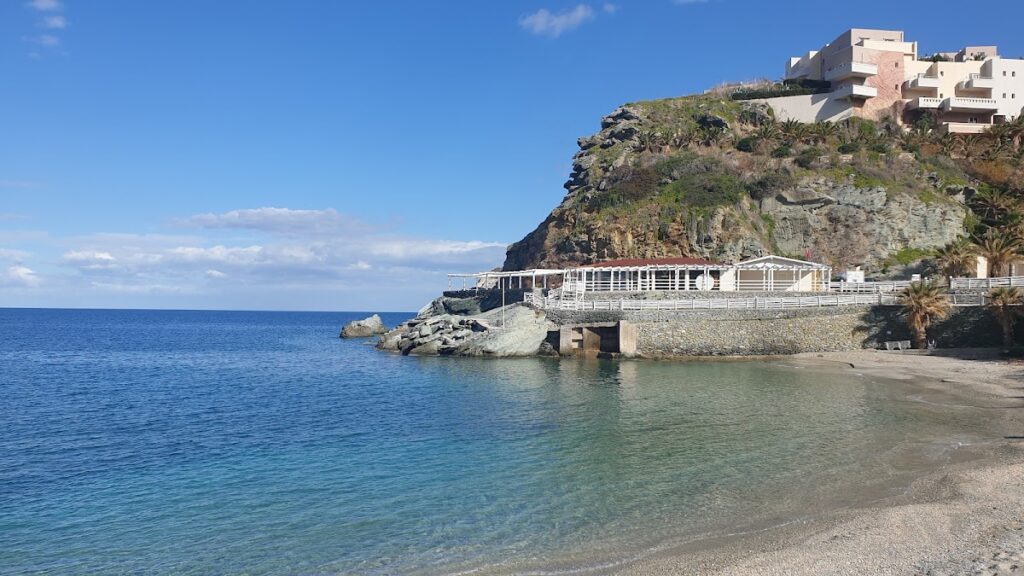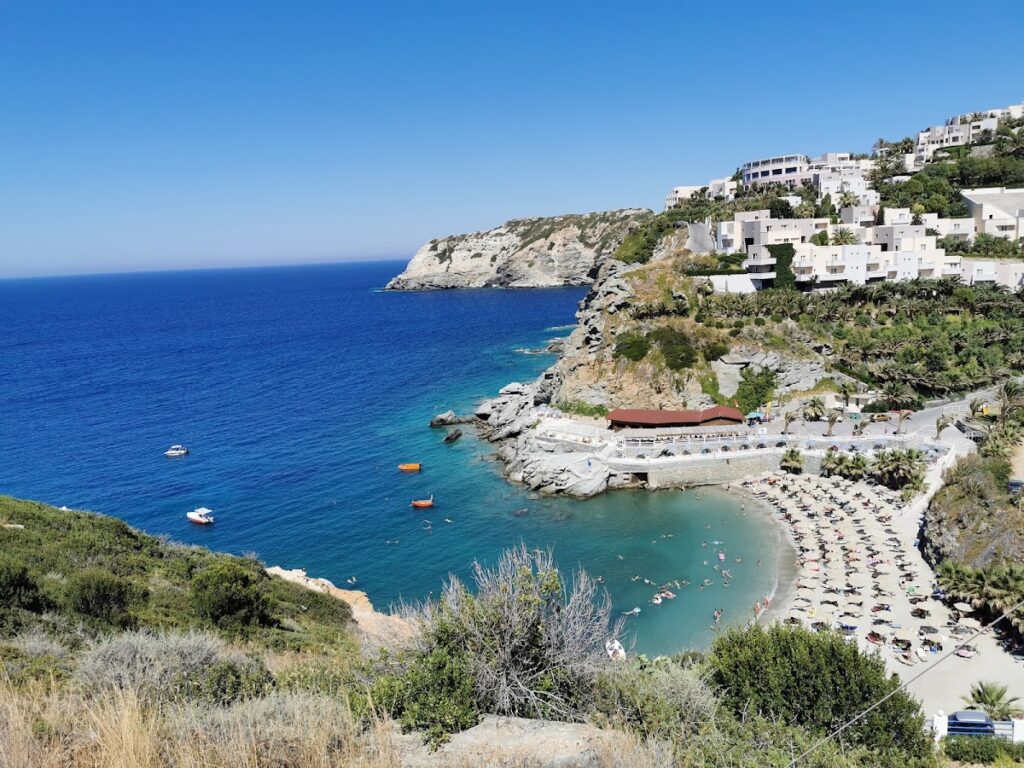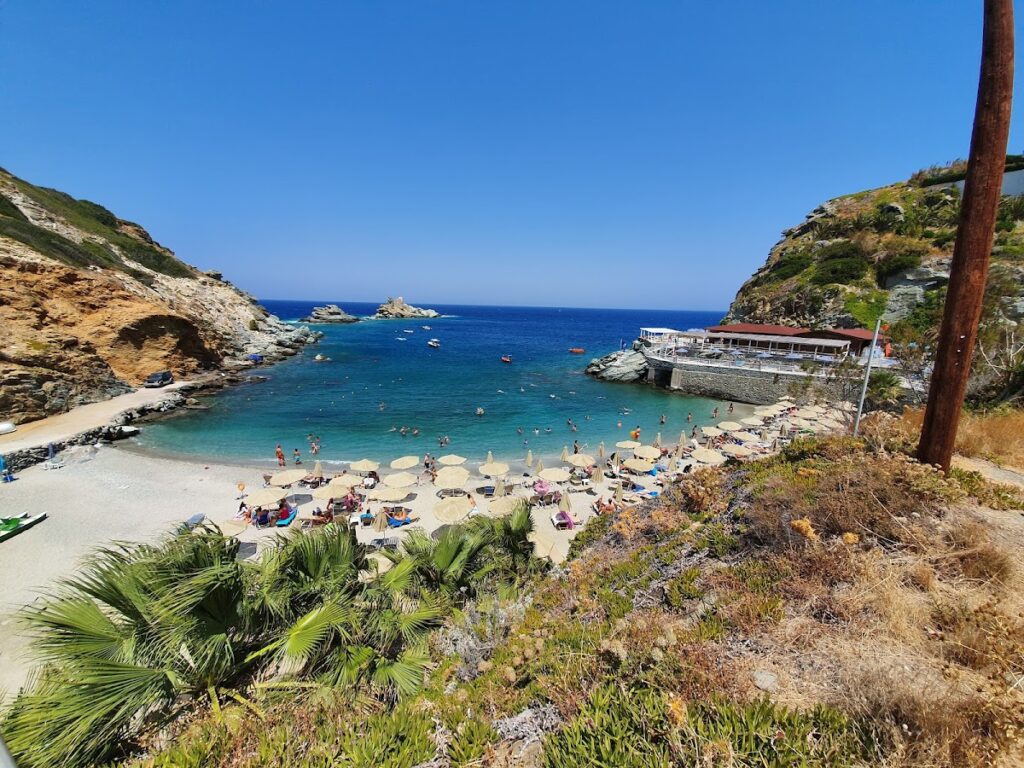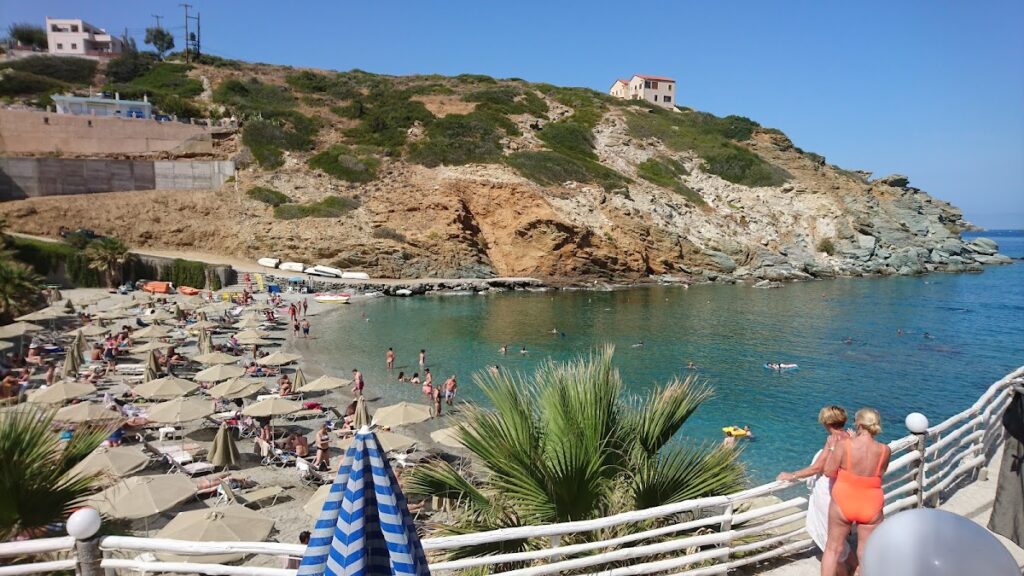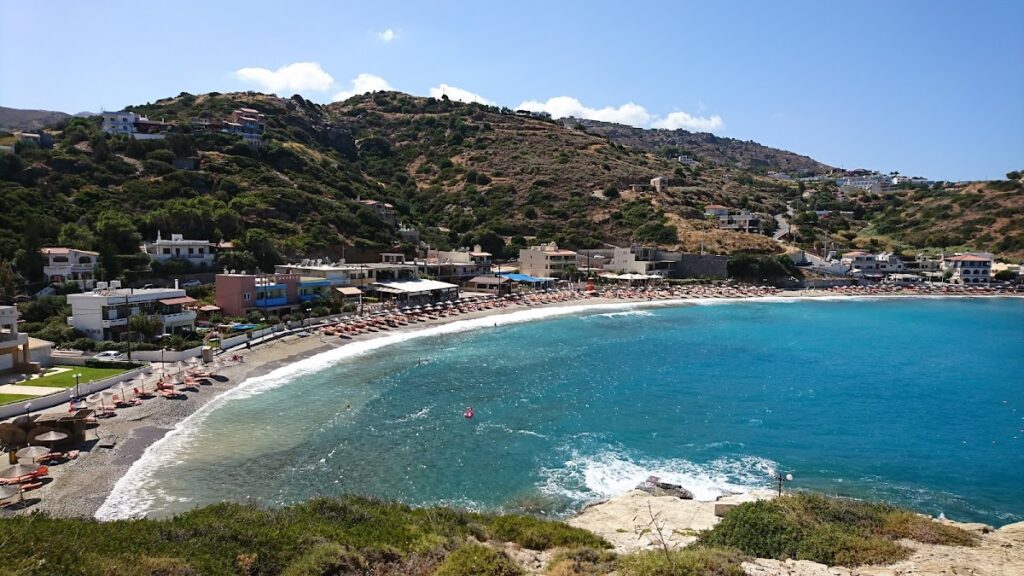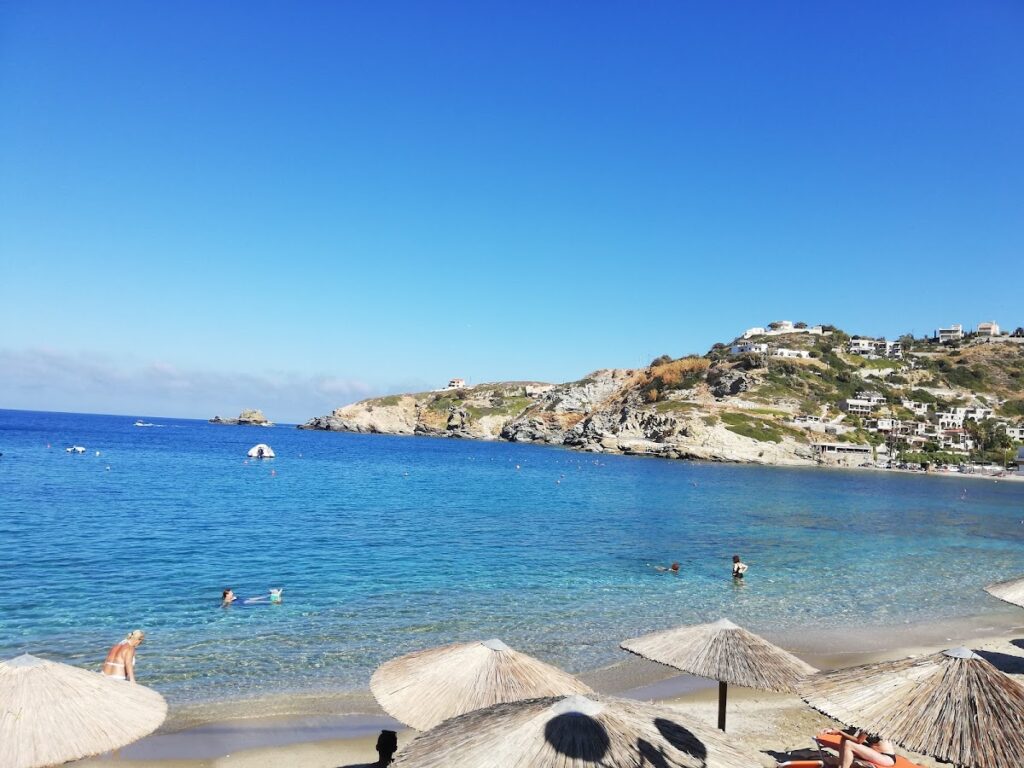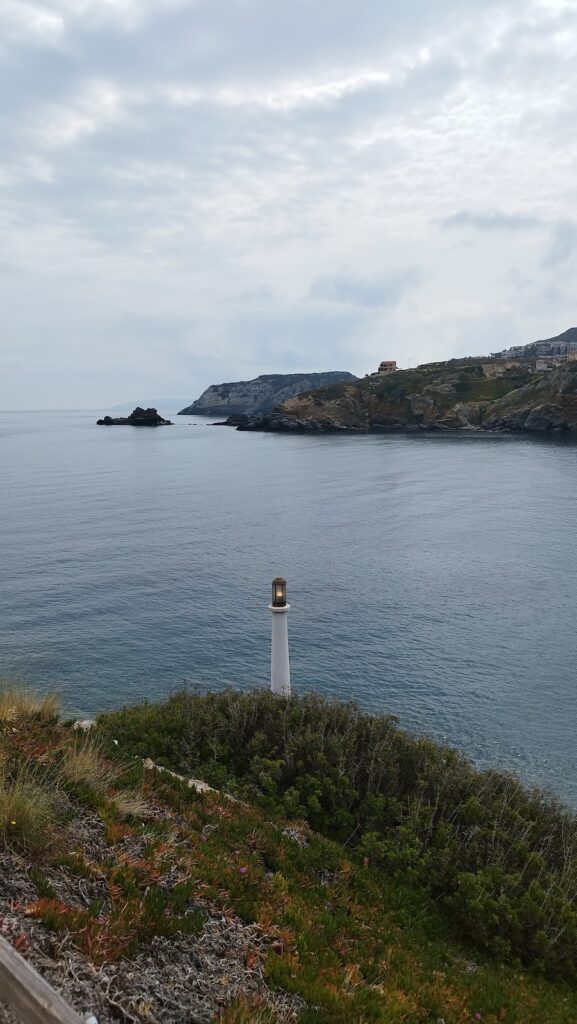Beaches near Kolymvitirio, in Heraklion region
Here is list of closest beaches to Kolymvitirio
- 1.7 km
- Ammoudara beach - Heraklion
- Sand
- Shallow
- Blue
Ammoudara, a beach extending 7km west from River Giofyros, located 1km west of Heraklion’s centre, draws in thousands of tourists annually, predominantly due to its expansive sandy coastline. Now a suburb of Heraklion, the beach is known for its unique brownish sand, with a rocky strip about 50m inland signifying the ancient shoreline.
Whether you prefer bustling environments or more private settings, Ammoudara caters to all. The coastline offers organized beaches equipped with sunbeds, umbrellas, beach bars, lifeguards, showers, changing rooms, and a plethora of water sports. Known for its year-round strong winds, Ammoudara is a popular spot for windsurfers. For a quieter experience, the beach’s western area, starting from the Pancretan Stadium and extending east towards the Xeropotamos wetland and dunes, is ideal. River Almiros and River Gazanos’ mouth areas, along with the Ellinoperamata industrial area, also offer peaceful beach spots.
The surrounding locale is also remarkable. The Almyros river spring, Crete’s largest water source, forms the area’s most extensive habitat. Nearby lies the Almiros gorge, an easy location for a leisurely walk. Alternatively, you can opt for a hike up the Stroumboulas mountain, Heraklion’s volcanic-like mountain.
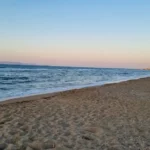
- 4.4 km
- Ellinoperamata beach
- Sand
- Shallow
- Blue
Situated 8km west of Heraklion city, Linoperamata, also known as Ellinoperamata, is a scenic sandy beach stretching up to 7km long, beginning from Linoperamata and culminating at the Pancretan Stadium, 1km west of Heraklion. The beach is uniquely bordered by the Almiros river in the west.
The locals do not frequent Linoperamata as much due to the presence of a local Power Station and heavy industries in its western region. Nevertheless, the beach boasts of clean water and a serene atmosphere. Unlike the highly organized beaches in the neighboring Ammoudara, Linoperamata has a more natural appeal, although there are a few hotels in the vicinity.
Open to the northern winds, the beach is often wavy, making it a favorite among windsurfers. Getting to Linoperamata from Heraklion is convenient via the city’s bus service.
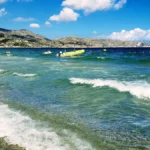
- 6.2 km
- Pantanassa beach
- Pebbles, Sand
- Deep
- Blue
Pantanassa, situated 12km west of Heraklion, is named after the Monastery of Panagia Pantanassa, which is dedicated to the Virgin Mary. The beach lies adjacent to the quaint port of Pantanassa. Prior to the establishment of the port, Pantanassa boasted an enchanting beach, concealed by a small pine forest and possessing crystal-clear waters. Now, the beach has been divided by the port, causing Pantanasa beach to lose some of its former allure. Nonetheless, it still retains its beauty, featuring pebbles and clear waters.
The beach offers amenities such as umbrellas and sunbeds, and some pine trees still grace the nearby cliffs. A pathway from the port allows for easy access. If hunger strikes, there are eateries in the port of Pantanassa and nearby areas. Visitors can combine their beach visit with a trip to the Pantanassa Monastery, perched atop the pine-covered hill above the beach. Built in the mid-20th century, it was envisioned to serve as a charity monastery, but the founder, Nikolaos Xenos, passed away before realizing his dream. Today, the monastery functions as a nunnery.
The Lefkadia area lies to the west of Pantanassa beach. Here, two secluded bays, largely unknown to most Heraklion residents, provide an ideal spot for relaxation. Recently, a beach bar was established and a trail leading to the beach was opened. Helidoni beach, featuring sandy and pebbly areas with a predominantly rocky seabed, is perfect for snorkeling. The western view is captivating, with the ruins of the old Paliokastro castle visible. Visitors can park in the nearby small pine grove and hike up to the castle.

- 6.7 km
- Helidoni Beach
- Pebbles, Rocks in places, Sand
- Deep
- Blue
Contrary to the prevailing belief that Crete’s scenic beaches are situated in remote areas far from major cities, those familiar with the island know that hidden gems are scattered across every corner. One such paradise is the Helidoni (Swallow) beach, just a stone’s throw from the historical Paliokastro fort in Rogdia near Heraklion. This haven is just a five-minute drive from the outskirts of Heraklion.
The beach known as Helidoni or Porto Helidoni is situated just south of Paliokastro and is nestled beneath the highway. A staircase with wooden steps descends to the sea level. The beach stands out for its cleanliness and the crystal-clear water that brings to mind the best beaches of southern Crete. The beach is oriented towards the east and, as a result, is typically calm, much like other beaches stretching from Ellinoperamata to Frankia. It is a quaint beach with a blend of fine pebbles and sand in certain spots. The seabed is quite rocky, making it perfect for snorkelling. There’s also a small canteen on the beach. Its name, Helidoni, is derived from the swarms of swallows that flock to this area annually.
Just a few meters east of the main Helidoni beach, another small sandy beach can be found, surrounded by picturesque rocks. This beach can only be reached by traversing the rocky coastline from Helidoni, lending it a tranquil atmosphere. There are stairs leading to the beach, but they pass through private properties, making them inaccessible to visitors.
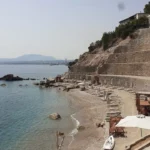
- 6.9 km
- Paliokastro beach
- Pebbles
- Deep
- Deep blue
Situated 14km to the west of Heraklion, Paliokastro, also known as Paleokastro, can be found on the western coastline of the Bay of Heraklion. This charming pebble beach is nestled into a green valley’s exit, which is intersected by streams flowing down from the Rogdia village. The cove of Paliokastro is securely flanked by tall cliffs and faces the east. A massive limestone rock towers over the eastern part of the beach, the summit of which was once the site of the Venetian fortress of Paliokastro. This fortress served as a defensive structure against enemy invasions to the Bay of Heraklion. The castle remnants suggest that it was constructed on the acropolis of the ancient town of Kytaeon.
Paliokastro is a beloved destination for the locals of Heraklion, who visit daily with their families. It has even led many to purchase homes in the area. Although not highly developed, the beach offers an idyllic setting for relaxation. Traditional food can be savored at various taverns, and several small hotels and rooms are available for stay. A mini market is also present on the beach, opposite an old limekiln, which is one of Crete’s best-preserved structures of its kind.
The beach’s western part boasts large pebbles and deep waters, making it a perfect spot for fishing and snorkeling. Natural stair formations on the rocks beneath the old fort provide a thrilling diving experience, with heights ranging from 1 to 20 meters. This spot is often frequented by children competing in diving contests. A tall, narrow, and dark cave is nestled between the beach and the rocks. Local folklore suggests this cave might have been a tunnel leading from the fortress to the sea, serving as an emergency escape route, although this remains unconfirmed. Paliokastro is easily reachable through the Heraklion-Chania highway, with a dedicated exit leading to the beach.

- 8.3 km
- Fraskia beach
- Fine Pebbles
- Deep
- Deep blue
The Panagia’s Fraskia Bay is nestled 24km northwest of Heraklion, on the western fringe of the Heraklion Bay. It is situated at a small valley’s exit, adjacent to the existing private settlement of Theseus. The name, Fraskia, originates from the Cretan term ‘fraski’, a type of jar used as a beehive by the Cretans. The surrounding area abounds in thyme, herbs, and shrubs, making it a perfect spot for beekeeping.
A significant portion of the coastline is peppered with alternating tiny coves of sandy and rocky seafloors, extending southwards to the area known as “The Garden of Priest”. Beyond this area, remarkable caves can be found. The sea, usually calm due to the infrequent eastern winds in northern Crete, was used by the Venetians as a harbour to shield their ships. Particularly on days when the northwest winds prevail, Panagia becomes the preferred choice for Heraklion’s boat owners.
Access to the beach is primarily by boat, with a strenuous path from the Heraklion-Rethymnon highway (before the exit to Ligaria) leading to the bay. A shorter, more accessible path starts from the neighbouring Theseus beach, but entry is restricted as it is private property. The beach is secluded, with no amenities. Sadly, unchecked construction by thoughtless locals has marred the shoreline. These squatters brazenly constructed cement bases on the beach, causing significant damage to the landscape with their refuse.
The beach is named after the Panagia (Virgin Mary) monastery, of which only ruined walls remain. A solitary shrine is the only reminder of a once-existing church. The church continues to celebrate annual festivities, with residents of Rogdia and Achlada villages arriving by boat. A dry creek with dense vegetation lies near the church.
In front of the settlement, there is a deep, pebbly beach with a calm, artificially created sea meant for the residents. The seabed starts shallow but deepens abruptly after a few meters. Umbrellas are provided for the village dwellers. Non-residents or visitors are prohibited from driving cars to the beach and must park near the village exit. A steep 1km walk is required to reach the beach, making the return journey quite exhausting. The beach may not be worth the effort unless permitted by a security guard to drive down. Alternatively, boats from the nearest harbour, Pantanassa, can be used. The deep waters are ideal for fishing, especially for avid snorkelers.

- 8.5 km
- Karteros beach
- Sand
- Shallow
- Blue
The Karteros Bay, situated at the exit of the synonymous Karteros Gorge, lies 7km east of Heraklion and stretches 3.5km to the east. It pays homage to the Byzantine General, Krateros, who in 824AC attempted to liberate Crete from the Saracens by landing his ships on the bay’s beach, but unfortunately, he was defeated. The bay encompasses two villages, Karteros and Amnissos, which have now merged due to the area’s rapid evolution. The area’s development can be attributed to its proximity to Heraklion and the presence of an exquisite beachfront featuring fine golden sand.
You’ll find numerous hotels, eateries, and beach bars in close proximity to the bay. Karteros Bay is exposed to the northern winds, and as a result, the water tends to be wavy. The water is shallow with almost no rocks, except for a few areas. The least crowded part of the beach is situated next to the “Nikos Kazantzakis” airport, 7km west of Heraklion, known as Florida. This part got its name from an old tavern that no longer exists and is the most serene of all the beaches. Compared to the easternmost beaches, Florida has fewer umbrellas and facilities. The river from the Karteros Gorge empties into Florida, creating a small wetland on the beach, which dries up during the summer. It’s certainly worth a visit, especially in the spring.
While in Florida, you should stop by the old Church of St. John and St. Nikon Metanoite, constructed within a large cave. Moreover, don’t be startled if you spot horses on the beach as it’s home to the Heraklion Riding Club.
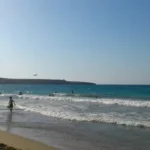
- 8.8 km
- Bourouni beach
- Fine Pebbles
- Deep
- Deep blue
Situated 19km northwest of Heraklion, nestled between the Capes Katarameno to the west and Bourouni of Rogdia to the east, lies Tripiti. This untouched stretch of coastline is north of its namesake settlement and boasts a pebbled shore alongside deep blue waters. Towering cliffs encase it, and to the east, exquisite caves can be found, giving the beach its name, Tripiti, which translates to ‘with holes’. These imposing cliffs contribute to the beach’s seclusion, making it one of the most remote beaches near Heraklion.
It’s worth noting that there is no vehicular access to the beach, evident by the remnants of a road that once led there until 1995. This road was entirely washed away by floods, leaving no trace of even a footpath.
The only drawback of this stunning location is its exposure to the north winds, which occasionally deposit litter along the coast. However, when the sea is tranquil, the beach offers an ideal getaway, particularly for those fortunate enough to own a private boat.

- 9.7 km
- Madés beach
- Fine Pebbles, Pebbles
- Deep
- Deep blue
Madé, also known as Madés, is a quaint coastal hamlet situated close to Ligaria, 20km to the northwest of Heraklion and 4km towards the east of Agia Pelagia beach. It can be found near the northernmost fringe of the Gulf of Heraklion, at a site known as Cape Bourouni of Rogdia. To reach this spot from Heraklion, you would have to travel along the highway to Chania and then take the Ligaria / Mades exit. A sign for Madé will appear just 1.5km into this route.
The village overlooks a tiny bay with a pebble beach, enveloped by several rocks and the small settlement of Madé. The local hotel manages this area well, offering both umbrellas and sunbeds to its guests. Nearby, you can find a handful of rooms, a mini-market, a beach bar, and a few taverns. The tranquillity of the beach attracts mostly locals who have constructed their summer homes here. Its rocky seabed teeming with fish makes it a perfect spot for fishing and snorkelling. However, the beach’s northern orientation leaves it susceptible to winds.
The signature feature of Mades is a pair of small islets that lie opposite the western end of the beach, which are perfect for snorkelling. The name ‘Mades’ derives from the Greek verb ‘Mado’, meaning ‘break easily’. It refers to the area’s stones, which are prone to cracking and are highly unstable.
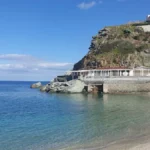
- 10.1 km
- Ligaria beach
- Rocks in places, Sand
- Normal
- Green
The Ligaria beach, nestled 21km northwest of Heraklion and just 1km east of Agia Pelagia, is shielded by the Bay of Ligaria from the common northwest winds of the region. Not far from here is the Panagia church, a relic from its days as the Panagia Ligariani monastery. The area is named after this monastery, which in turn, derives its name from the abundant osier plant, also known as ‘ligaria’ in Greek, famous for its pliable stems and lovely flowers.
The beach is an enchanting spot with its rough sand and serene, turquoise water. The presence of small boats adds to the charm of the scene. While the eastern part is more exposed to waves and tends to gather more debris, the western side boasts cleaner water and a flat sea. Smooth rocks are found close to the shore except for the western part of Ligaria which has small sandy areas. The beach is well-equipped with facilities like umbrellas, sunbeds, water sports, a diving school, beach bars, restaurants, and accommodations. However, parking can be a challenge, especially on weekends due to the influx of locals.
A trail leading northeast from the west end of the beach takes you to the top of the cape safeguarding Ligaria. Adjacent to this cape lies a secluded little beach named Parasfougario. It has sand and pebbles but is exposed to the wind. A stone pathway starting from a cliffside house leads to this beach, but it is off-limits as it falls under private property.

No results available
ResetBeaches in other nearby areas
No results available
Reset